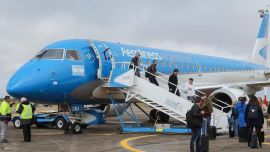Rescuers have found human remains during the search for a Chilean Air Force plane that went missing en route to Antarctica with 38 people aboard, a provincial government leader said Wednesday.
Search teams are combing waters off the southern tip of South America for any sign of the C-130 Hercules transport aircraft, which disappeared late Monday.
Chile's military have yet to publicly announce the discovery but said earlier that search and rescue teams had recovered floating debris and personal items suspected to come from the plane.
But José Fernández, the governor of sparsely populated Magallanes region in Chile's far south, said the air force had confirmed the find to him.
"They told us that they had found other airplane debris as well as human remains from those on board," Fernández told reporters in provincial capital Punta Arenas, where many family members were gathering to be close to the rescue effort.
His comments came shortly after the Air Force issued a statement saying that, out of respect for family members, all information regarding remains will be "analyzed, validated and communicated" by the Air Force itself.
Air Force General Eduardo Mosqueira said “sponge” material, possibly from the plane's fuel tank, was found floating roughly 30 kilometres (19 miles) from the place the C-130 Hercules last had radio contact.
The debris will be analyzed to see if it corresponds to the missing plane, he said, adding that the process could take up to two days.
The C-130 Hercules took off Monday afternoon from a base in far-southern Chile on a regular maintenance flight for an Antarctic base. Radio contact was lost 70 minutes later.
The debris was spotted by a private plane assisting in the search, and officials said a Brazilian ship in the area equipped with instruments will next scan 3,200 metres (10,499 feet) underwater at the site.
"We estimate that the debris may in fact be from the C-130 fuel tank," Mosqueira said.
The discovery came as Chilean officials had expanded the search for the missing military plane.
Mosqueira said the search area covered an area of about 400 by 450 kilometres (250 by 280 miles) and he said improved visibility was helping the crews of searchers using planes, satellites and vessels from Argentina, Brazil, Uruguay and the U.S. as well as Chile.
The search area extended over treacherous waters of Drake Passage between the tip of South America and the Antarctic. The plane was carrying 17 crew members and 21 passengers, three of them civilians.
The two pilots had extensive experience, according to the Chilean Air Force, which said that while the plane was built in 1978, it was in good condition. The Air Force said it flies this route monthly.
The four-engine C-130 is a “military workhorse" and experts say in general well maintained airplanes can fly for 50-plus years.
The aircraft would have been about halfway to the Antarctic base when it lost contact, officials said, adding that no emergency signals had been activated.
The plane had taken off in favorable conditions, though it was flying in an area notorious for rapidly changing weather, with freezing temperatures and strong winds. Seven hours after contact was cut off, the air force declared the plane a loss, though there was no sign of what happened to it.
Ed Coleman, a pilot and chair of the Safety Science Department at Embry-Riddle Aeronautical University in Prescott, Arizona, said rapidly changing weather in the Antarctic makes it a difficult place for pilots.
Air masses converge there, driving storms with powerful wind gusts, while stirring the sea with swells 6 metres (20 feet) or bigger, he said. Flying becomes challenging, and making a smooth sea landing nearly impossible, he said.
“You can have a clear sky one minute, and in a short time later storms can be building up making it a challenge,” he said. “That causes bigger swells and rougher air.”
The inhospitable Antarctic is equally formidable to rescuers, who have to respond quickly to pull any survivors from the cold, rough waters, he said.
– AP


























Comments